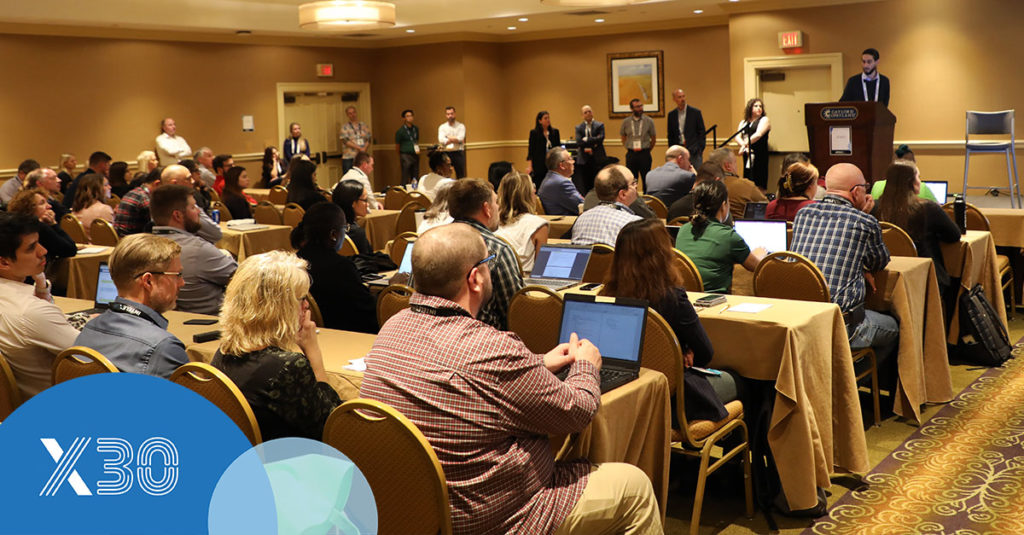Intelex30: How ESG Reporting and EHS Management Systems are Responding to a Changing World
November 30, 2022

Some organizations will face the reality that spreadsheets and manual methods for collecting data will not be able to keep up with the requirements of ESG reporting and EHS management.
The world has changed a lot over the last three years. In many ways, it’s become more unpredictable, with supply chain disruption, economic concerns and geopolitical volatility becoming part of our daily existence. Yet through it all, frontline workers are there to keep the machinery of the global economic engine moving, so keeping them safe while improving the way they work has never been more important.
With that in mind, the Intelex User Conference returned in Nashville, Tennessee from November 3-4. For two days at the Gaylord Opryland Resort, we met with customers, partners and industry experts to dig into the present and future developments of EHS to see how we can support the needs of frontline workers everywhere. Since there’s no better way to learn than speaking with the people who use our product every day, we came away with enough ideas and insights to keep us on the path of EHS innovation for years to come.
Day 1 began with an inspirational keynote by Captain Chris Cassidy, NASA astronaut and former Navy Seal. Captain Cassidy was the Commander on the International Space Station for Expedition 63. He was also deployed twice to Afghanistan, where he received a Bronze Star and a Presidential Unit Citation. His keynote provided insight into his remarkable journey, as well as important lessons on mentorship and camaraderie, the importance of documentation, risk, making good decisions in a crisis and why you should pay attention to leading indicators. It was a remarkable introduction to the life of someone who has been a frontline worker in situations that are more intense than many of us will ever experience, and it set an exciting tone for the days ahead.
The World of ESG
The afternoon sessions began with a deep dive into a topic that has been on the agenda for many organizations recently: ESG Reporting. Trevor Bronson, Director of Portfolio Strategy at Intelex, and Alexis Fuge, Senior Director of Sustainability at Fortive, led “The ‘E’ of ESG and the Changing Reporting Landscape,” looking specifically at how organizations might manage materiality and the enormous amounts of data required for ESG reporting.
The first topic was increasing ESG regulations, such as the upcoming Corporate Sustainability Reporting Directive in the European Union and the proposed changes from the U.S. Security and Exchange Commission (SEC) relating to Greenhouse Gas (GHG) reporting for Scope 3 emissions along the supply chain. These changes will require organizations to collect considerably larger amounts of data. While this might seem overwhelming, many EHS teams are already collecting much of this data. This interaction not only creates an effective intersection between EHS and ESG, but it also potentially raises the value of ESG as a value center for the business.
However, some organizations will likely have to face the reality that spreadsheets and manual methods for collecting data will not be able to keep up with the requirements of ESG over the next few years. Scope 3 emissions, in particular, will likely generate more data than any manual process could effectively manage and report. Digital solutions will not only make it easier to collect data for ESG reporting, but it will also facilitate better analysis and higher data quality.
The Frontline EHS Worker
One of the best things about conferences is the opportunity to get multiple experts together in the same room for a deep and challenging discussion on some of the most important topics in the field. The afternoon session “From the EHS Trenches: Maximizing Opportunities and Overcoming Challenges” was a panel discussion with Scott Gaddis from Intelex, Brian Fenner from General Motors, Robert Bogle from Valmont Industries, Kelsey Hein from Ecobat and Paul Dober from American Electric Power Co. Inc (AEP).
The panel began with a look at the opportunities and challenges of implementing digital solutions to support EHS management systems. Panelists agreed that leadership support was a critical component of any digital roll-out. This means extensive planning and frequent discussions to ensure that the configuration is exactly what the organization needs. It also means rigorous and transparent stress testing before roll-out to ensure that all the users understand the solution and what it can do. Frontline workers need to feel that they have ownership of the solution and that they understand their role in the ongoing continuous improvement of the EHS management system over time.
The discussion moved to safety culture, with emphasis on the importance of partnership and communication between leadership and frontline workers. Leadership needs to set a tone that demonstrates support for health and safety initiatives while frontline workers need to understand the importance of safety and how to think about risk in the workplace. Panelists discussed the importance of distinguishing between safety culture (the safety values and attitudes of the organization) and safety climate (how the organizations measures the way workers feel about the safety culture), which can be an important way of understanding an organization’s level of safety maturity. How leadership measures and responds to the safety climate is particularly important. A positive safety climate does not necessarily mean that safety is trending in the right direction; it could mean that frontline workers are complacent or unaware of the complex risks in the work environment. Improving safety culture should not include punitive measures against workers who make mistakes. Instead, frontline workers need to feel that safety culture is a partnership between leadership and workers with the goal of keeping everyone safe. Overall, panelists agreed that safety culture is not something that can be implemented quickly or according to a standard playbook. It takes a long time to develop and is unique to every organization.
The panel discussion wrapped up with a look at the importance of leading metrics. To make a significant difference in reducing incident rates, organizations need huge amounts of data on incidents and root causes, as well as safety observations that can prevent accidents from happening in the first place. This can present a number of challenges, such as the difficulty of analyzing qualitative data in the form of safety observations, convincing leadership of the importance of data to support leading indicators and creating usable, data-based information for the frontline worker. Panelists referred to this challenge as “mining for gold,” suggesting that many organizations are still struggling to produce useable leading indicators from the data lakes in their systems. Applications that provide easy-to-read dashboards are providing an accessible way of presenting much of this information to the frontline worker in a way that helps them apply it and improve the way they do their everyday work.
In Part 2 of our series looking at Intelex30: The User Conference in Nashville, we’ll learn more about how health and safety leaders are navigating the increasingly complex world of EHS and ESG.





